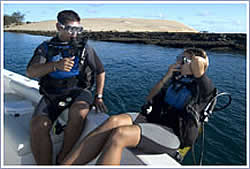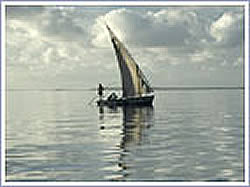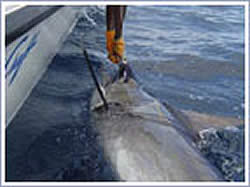the sea life gives you brightly coloured coral reefs, with sea anemones and other brightly coloured plant growth as well as turtles, dugongs,whales, manta rays and dolphins and more than 2000 species of fish, including the largest fish, the whale shark.
Note that spear fishing requires a licence.
BAZARUTO ARCHIPELAGO DIVE SITES
Lighthouse Point (average depth 12m), 12 Mile Reef (average depth 14m), Whale Rock (max depth 12m),
Greek Temple (average depth 13m), Manta Reef, Rainbow Runner Dive and then Gengarema Point (max depth 23m).
Bazaruto Island reefs include:-
• Brindle Bass Ridge (North Point)
This large reef has a maximum depth of 18 metres and features impressive concentrations of snappers, angelfish, rubberlips, brindle bass and reef sharks. An unusual depression, The Toilet Bowl, is lined with dazzling soft corals.
• Potholes (North Point)
A series of shallow potholes at a depth of about 12 metres, this site can be dived only in flat conditions. You fin from pothole to pothole and the larger ones often shelter black-tail reef sharks. Other potholes are lined with soft corals and have interesting tunnels to explore.
• Manta Ray Reef (North Point)
This is a flat reef at a maximum depth of 15 metres where schools of fish such as crescent-tailed big eyes and blue-banded snappers are regularly encountered. The reef has spectacular concentrations of anemones sheltering both nose-stripe and two-bar clownfish. The reef is also frequented by green turtles.
• Rainbow Runner Reef (North Point)
This reef has a maximum depth of 25 metres (on spring high tide) where divers should concentrate on watching the open ocean above the sea floor. Manta (in season) and spotted eagle rays, potato and brindle bass, kingfish, rainbow runner, green jobfish and Zambezi sharks pass through this area. The reef also has impressive accumulations of green-tree and whips corals.
• Turtle Ridge (North Point)
A narrow ridge at a depth of 14 metres, frequented by turtles and game fish such as barracuda.
• Five-Mile Reef
Situated off the south-eastern beaches of Bazaruto, this reef is not as diverse as Two-Mile Reef and is therefore not a favourite among local dive masters. Some divers have seen Zambezi sharks in the 10-metre shallows. Five-Mile has a very interesting bottom structure and the outside ledge is occasionally visited by large pelagics.
• Two-Mile Reef
A short barrier reef protecting a narrow channel between Bazaruto and Benguerra. It's particularly well known for its excellent snorkelling sites inside the reef such as Aquarium, as well as for a host of exciting dives on the outside. The dives range between six and 21m. The flat-topped reef supports a colourful diversity of hard and soft corals, with a highlight being the numerous schools of reef fish such as coachman, fusilier, snapper and surgeon. Schools of large pelagic and reef fish also frequent the area and there's a chance of encountering potato bass; kingfish; barracuda; devil fire fish and honeycomb ray's and reef sharks. Occasionally, in season, manta rays have been spotted here.
The archipelago is home to all five marine turtle species of the western Indian Ocean, the most common are loggerheads and green turtles.
They are highly endangered and in urgent need of conservation.
The turtles come to the beaches to breed every year and their nests are extremely vulnerable to predators.
Other threats include fishing nets, trawlers and hunting.
Bazaruto Archipelago falls into the Eastern African Marine Eco region, which stretches over a 4 600 kilometre coastline, from South Africa to Somalia.
There are over 2 000 fish species, 100 hard and 27 soft coral species.
The world's largest fringing reef, four whale and five dolphin species .
The extremely rare Dugong can still be seen here and Nile crocodiles occur in the shallow lakes and pools on the islands .
|


|
| |
|
Activities
on offer are;
Cruises on traditional Dhows (old arab style wooden boats which the local fishermen have used for centuries)- Deep Sea Fishing
- Diving
- Island Tours
- Saltwater Fly Fishing
- Snorkeling
- picnics
- lots and lots of R& R (Rest and Relaxation).
There is an overriding sense of history and legends of the fantastically rich Land of Ophir and the left over legacy of trading dhows bearing slaves and ivory to the East
There is strong pro-active support, by all role players, against illegal longlining in the park’s area. This has even led to physical engagments against longliners caught fishing illegally in the park. This has had a very positive outcome and as a result of these conservation efforts the future of the sanctuary looks most promising.
Tag & Release;
In 2001, Mrs Eleanor Bullen from Durban's Oceanographic Research Institute (ORI) together with WWF-SA, started a "Tag & Release" programme, which is also well supported by most of the Archipelago's roleplayers.
A novel idea is practised by lodges and charter operations and that is to award a fisherman who releases a billfish, with a T&R certificate as well as an ORI certificate.
|


|
|

